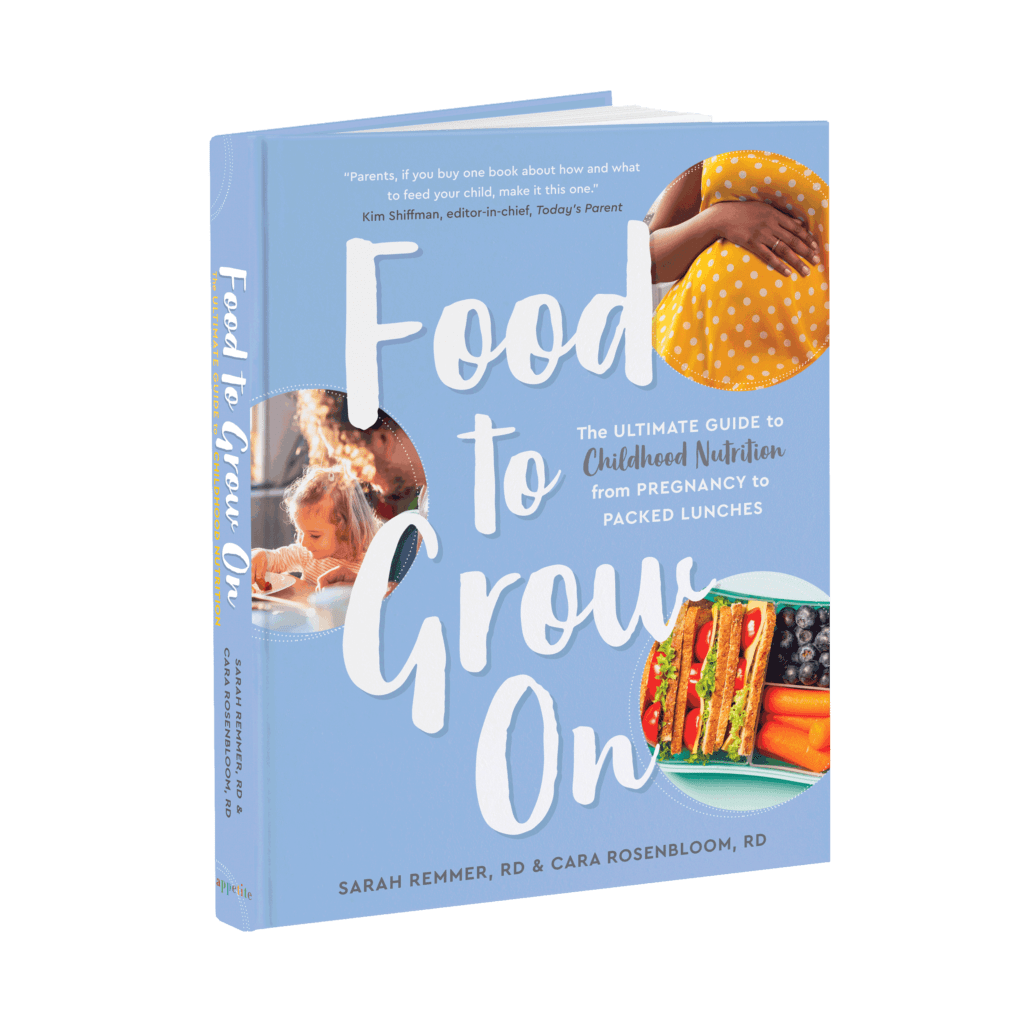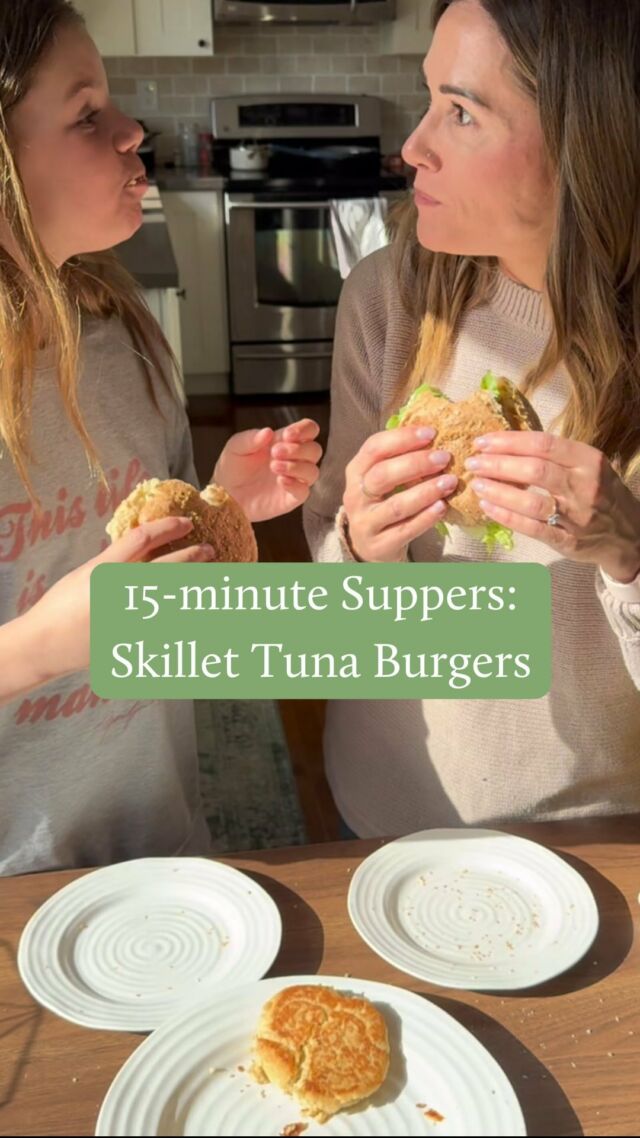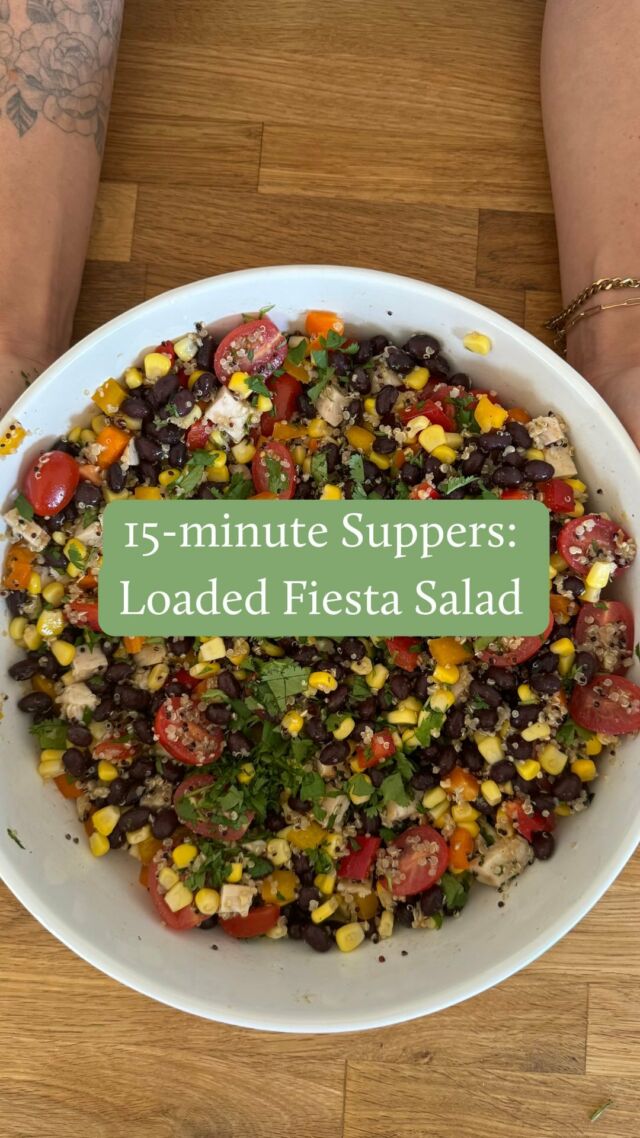Terrified that baby-led weaning or feeding will cause your child to choke on solid foods? Here’s 8 tips to prevent choking when baby-led weaning, plus a list of foods to avoid.

Want to read this post in a visual way? Check out my Google web story on Top Tips to Prevent Choking when Baby Led Weaning.
Baby-led weaning is a very popular–and now almost mainstream–way to introduce your baby to solids. Essentially, baby-led weaning is skipping purees and spoon feeding altogether and allowing your baby feed herself with finger foods. Your baby eats with you during family meal times–and often even family foods–right from the start, around six months of age.
The potential benefits of baby-led weaning are:
There are many benefits to baby-led weaning listed in my comprehensive guide.
Need personalized nutrition support?
Book an appointment with one of our pediatric dietitians today!
But, won’t my baby choke?
A common concern is that baby will choke on solid foods. Now, choking is serious business, and although it’s very rare, it’s important that you’re aware of common choking hazards and that you are prepared (ie. take infant CPR and First Aid) just in case. But choking gets confused with gagging—which is completely different. Gagging is extremely common when babies are starting solids. The gag reflex keeps larger food pieces out of the wind pipe and near the front of the mouth, only allowing very well-chewed foods to the back to be swallowed. It’s a safety mechanism to prevent choking! And it happens A LOT if you choose the Baby Led Weaning route, especially in the beginning. It’s not a bad thing!
Here’s what you’ll find in this post:
- The difference between gagging and choking
- Why it’s important to let baby self-feed
- Why it’s important to always watch your baby while they’re eating
- Why it’s important to use a proper highchair
- List of common choking hazards
- Month-by-month list of appropriate foods (size, texture, shape)
- Avoiding distractions at mealtimes
- Why you should take infant First Aid and CPR
- This is the number one choking hazard (and might surprise you!)

Starting solids? Don’t panic.
Starting solids is an exciting milestone in your baby’s life, but it can also be confusing, especially when you’re overloaded with conflicting information on how and when to do it. Download your free guide to starting solids and clear the confusion!

Yet I hear from many moms who want to try baby-led weaning, but are too terrified that their baby will choke on solid foods. Some good news recently came from a new study of 206 babies, called “A Baby-led Approach to Eating Solids & Risk of Choking.” The study compared a group of baby-led weaners (whose parents were given extra education on how to safely practice baby-led Weaning) to a “control” group.
The control group babies mostly started solids using the standard puree method. While the baby-led weaners did gag more at six months than spoon-fed babies, they gagged less by eight months of age. Because by this time, the baby-led weaners had gotten used to eating solids, and the pureed feeders were just starting! And there was no difference in the number of actual choking episodes reported between the two groups.

Gagging – why it’s nothing to be concerned about
Your baby will gag. A lot! Especially in those first few weeks of solid foods and if you’re letting your baby self-feed with finger foods. The best thing to do is to remain calm and cool and encourage your baby to work it out by staying positive, smiling, and NOT PANICKING. This is hard, but really important. If your baby sees you freak out, they might too, and it may possibly turn a normal experience into a scary one.
One common misconception is that gagging is the same thing as choking. Gagging is extremely common when babies are starting solids. In fact, as mentioned above, gagging is a safety mechanism to prevent choking when baby led weaning. Gagging doesn’t usually bother babies; but it does often bother parents! A potential benefit of introducing real foods sooner, is that the gag reflex is further forward in your baby’s mouth. This reflex moves farther back on your baby’s tongue as he ages.
In contrast to gagging, choking occurs when the air tube is blocked. If your baby bites off a perfectly round shaped piece of hard food, it is possible they will choke. But there’s a lot you can do to prevent it…

Here are my top eight tips to prevent choking when baby-led weaning:
1. Let your baby self-feed
If you put food into your baby’s mouth, it may immediately fall to the back of your baby’s throat, without having a chance to control it with their tongue and chew it. In the study quoted above, a total of three out of 206 babies choked to the degree they required emergency health care assistance. Of these three babies, two choked on milk and the third choked when food was placed in its mouth. Moral of the story? Never put a piece of food into your baby’s mouth.
Your baby might enjoy experimenting with a self-feeding spoon. It’s also going to be a messy learning experience, so you may want to stock up on bibs!
2. Watch your baby while they eat
While you can hear your baby gagging, you can’t hear them choking. Choking is often silent, which is why it’s so important that you sit down and eat with your baby. Don’t continue preparing food, do the dishes or go put a load of laundry in. I know that it’s tempting to multitask (I really do!), but when baby is learning how to eat, it’s important to be there to supervise and facilitate a positive and safe experience.
3. Use a proper high chair
It’s important to make sure that your baby is comfortable and secure in their highchair (I love this feeding highchair!). Their feet should ideally be resting on a firm surface and their legs should be bent at a 90 degree angle. This helps to make sure that baby is focusing more on eating and less on keeping their bodies upright and balanced (and prevents a very wiggle baby!). And unless there’s a risk of your baby falling or climbing out, I preferred not to buckle the high chair with my babies. That way you can get them out quickly, if needed. Make sure baby is sitting upright, and not in a reclining position.

4. Don’t offer food in choking-hazard size
Your baby’s air pipe is about the width of one of their finger nails, so it’s important to serve thinly sliced foods. Avoid round items like whole grapes, cherries, nuts, berries, cherry tomatoes and wieners. Instead, slice them in halves or quarters.
Things like big gobs of peanut butter, popcorn and stringy fruits and vegetables are also choking hazards. For harder fruits and veggies, I like to cut them in the shape of a potato chips: long enough for a beginner to grasp, but thin so that choking isn’t likely.
Here’s a full list of potential choking hazards:
- Hard vegetables raw, such as cut baby carrots or raw beets
- Firm fruit with and without peels
- Chunks of firm meat or cheese
- Fruits with pits or seeds (that haven’t been removed), like a whole plum or peach
- Whole grapes
- Popcorn
- Marshmallows
- Whole nuts
- Fibrous and stringy foods like celery, pineapple, or asparagus
- Hard candies, mints, or cough drops
- Fish with bones
- Snacks with toothpicks or skewers
- Whole hotdogs or sausages
Alternative ways of serving:
- Steam vegetables and fruit.
- Peel and grate hard vegetables and fruit like carrots, parsnips, apples, and zucchini.
- Grate cheese.
- Always remove pits and seeds from fruit.
- Slice grapes into lengthwise halves or quarters.
- Thinly spread peanut butter or any other nut or seed butter on toast.
- Debone fish.
- Serve fresh, frozen, or canned (rinsed) corn instead of popcorn.

5. Offer appropriate size, texture and shape of food
Through the ages of 6 to 12 months, you can expand the textures and sizes of foods that are suitable to serve. As babies grow, they slowly develop more mature chewing and swallowing skills, as well as better finger dexterity and fine motor skills. This helps them handle firmer, smaller pieces of food. As you watch your baby eat, you will notice changes in the size of pieces that they can pick up.
In terms of texture, it’s important to steam fruits and veggies and test the foods to make sure you can mash them with your tongue on the roof of your mouth, especially in the beginning. It’s much easier to cough up a piece of soft food, than hard food!
Every baby develops at a slightly different rate, and that’s okay! While one baby might be ready to pick up small peas and blueberries by 9 months, another might not be ready until 11 months. These suggestions are just a loose guideline of which textures and sizes of food to offer at each age and stage. Of course, pay close attention to your own baby to know what’s right for them.
As your baby becomes a more confident feeder, move to the next stage. By the time they turn one, your baby will be self-feeding like a pro—you got this!
6 TO 7 MONTHS
Protein/iron-rich:
- Meat and poultry: Minced; pureed; slow-cooked and shredded; or meatballs or patties
- Low-mercury fish: Deboned, then soft-cooked or pureed fish
- Eggs: Hard-boiled and mashed; omelets cut into strips; or scrambled
- Legumes: Cooked and mashed or pureed beans, lentils and chickpeas. Silken or mashed firm tofu
- Cheese: Thinly sliced or grated
- Nut butter: thinly spread on toast strips; or stirred into infant cereal
Fruits and vegetables:
- Soft fruits: Peeled and cut into large strips – try avocado or ripe pear.
- Bananas: Leave half the peel on to help baby’s grip
- Hard fruits and vegetables: peeled and steamed until soft, then mashed or pureed, or cut in large strips as finger food. Try green beans, carrots, zucchini or apples
Grains:
- Whole grains: Cooked and spoon-fed quinoa or oats.
- Whole grain bread: Toasted and cut into strips.
- Iron-fortified infant cereals: Mashed with breastmilk or formula .
8 TO 9 MONTHS
Continue to serve any of the foods from 6-7 months, and progress to these textures when your baby seems ready:
Protein/iron-rich:
- Meat, poultry and fish: Medium-sized, soft-cooked pieces.
- Legumes: Lentil or bean patties (see my homemade lentil patties here).
Fruits and vegetables:
- Soft fruits: Medium pieces of soft or steamed options such as raspberries , kiwi, or peach
- Raw vegetables and fruits: peeled and grated apple or carrot
Grains:
- Large-flake or steel-cut oats: Thicker than baby’s first iron-fortified baby cereals
- Pasta: Bite-size cooked shapes, such as penne or macaroni
- Firmer grains: Farro or barley
10 TO 12 MONTHS
Continue to serve the foods above, and progress to these textures when your baby seems ready. Now that baby has better dexterity, pieces can be smaller.
Protein/iron-rich:
- Meat, poultry and fish: Smaller pieces of pulled roast chicken
- Legumes: Cooked whole beans or lentils and cubed firm tofu.
- Dairy: Cheese cubes.
Fruits and vegetables:
- Hard vegetables: smaller pieces of raw peeled cucumber or steamed carrot coins
- Dried fruit: Cut apricots or whole raisins.
- Fruits: Raw small pieces, such as sliced grapes and small whole blueberries
Grains:
- Pasta: Offer as part of mixed meals, such as ravioli, spaghetti and meatballs, or soup.

6. Don’t let your baby play with toys or watch TV during meals
Your baby needs to focus on learning the new skill of eating. And a distracted baby is more likely to choke! Remove all distractions, including toys and screens.
7. Take an infant CPR class
Chances are, your baby will be fine and not have a choking episode, especially if you’re following the tips above! Despite this, before anything else, this is priority number one. Make sure you take a baby first aid and CPR training course. Find one through your local hospital, public health center, or community center. It’s so important to be confident and knowledgeable about how to react in an emergency like choking way, you are confident in dealing with choking if it does happen.
8. Be careful with this one food, in particular
The #1 most common food that Baby-led Weaners choke on is full apples. I suggest serving apples peeled, sliced thinly and steamed for beginners. Once your baby is older, you can use a cheese grater to grate hard foods like apples. Here’s a great Flourless Oatmeal Apple Muffin recipe to try too!
I hope that these tips to prevent choking help you feel more confident in using Baby led Weaning!

Commonly Asked Questions About Choking and Baby-Led Weaning
Prepare yourself by taking an infant CPR and first aid training course. Find one through your local hospital, public health center, or community center.
It’s important to know that there is no single “right way” to introduce solids to your baby, whether you want to start with traditional spoon-feeding or try baby-led weaning). There are many potential benefits to baby-led weaning, including improved dexterity, early oral-motor skill development, self-regulation, ease for parents, decreased picky eating and more.
Safe finger foods include: pieces of soft-cooked vegetables and fruits; soft, ripe fruit such as banana; finely minced, ground or mashed cooked meat, deboned fish, and poultry; grated cheese; and whole grain toast strips with a thin layer of butter or nut butter. More baby-led weaning tips.


Food to Grow On
Food to Grow On is the definitive guide to childhood nutrition, packed with practical advice to support you through pregnancy, and up until your little one starts school.
Laid out in an easy-to-navigate question and answer style, this book provides practical advice and support from Sarah Remmer and Cara Rosenbloom, two trusted registered dietitians (and moms). Food to Grow On is packed with hard-earned parenting wisdom and the very latest research in pediatric nutrition, so you will feel supported, understood, and ready to help your child thrive.
Did you know that we offer personalized nutrition counselling for kids and families? If this is something you’d like to learn more about, please visit The Centre for Family Nutrition.
*This is a guest post was originally written by guest dietitian and writer Jennifer House, RD and then revised by Sarah Remmer, RD







Comments
kelsey says
such a helpful article! i’ve watched several youtube videos on this and even read part of a book on it but this has been the most straight forward so far!
Sarah Remmer says
Hi Kelsey, thank you so much for taking the time to write this kind review. It means so much to me! I’m so glad it’s helpful.
Rachel Langston says
I have tried baby led weaning multiple times with my son but he just gags and throws up perfectly good breast milk! Then, It scares him and he refuses to eat anything else. What should I do? Right now we are just feeding him purées. He is 10 months
Sarah Remmer says
Hi Rachel. Thanks for reaching out. Sorry to hear that you guys are having trouble. At 10 months old your son should be consuming more than purees. I’d love to know more about your feeding plan, your little one, and how I can help. Please email my lead counselling dietitian Kathryn at kathryn@sarahremmer.com. She is a fellow mom and will be a fantastic resource moving forward. You’re doing a great job – contacting a Registered Dietitian is step one. Let’s get you started!
Becky Blair says
You may want to re-read the study you are citing on this page where you say there is no difference between the intervention and control groups for choking risk. The BLISS trial used a modified version of BLW and compared to those infants fed by current nutrition guidelines. We can’t say that there is no difference in BLW as originally designed compared to infants not being fed by this approach.
Sarah Remmer says
Thanks Becky – I’ll pass this along to Jennifer House (the author of the blog post!)
Tony K Chow says
Thanks! Thoughts on how to safely eat bananas? Our baby grabs it and wants to shove the entire banana in her mouth and it ends up breaking off an inch long piece. This doesn’t seem safe.
Sarah Remmer says
I totally understand how nerve wracking this can be. Make sure that the banana is ripe (not green) and always sit with her when she eats. Recognize the difference between choking and gagging and she will be fine. If you’re nervous try cutting the banana length wise. That way she can still pick it up and feed herself, but she will get less in her mouth with each bite.
hercules says
Great tips thanxs for sharing.
Lindsey Pine says
I will definitely refer clients looking for child nutrition tips here! Great info!
Denise says
Great tips on baby led weaning and keeping baby from choking!
Erin says
Thank you for sharing this! This was my biggest concern starting this process with my baby. Such great info!
Katie Cavuto says
Such great information!! Not talked about too often
Amy Gorin says
Great tips! Thank you!
Sarah Remmer says
Thanks Amy!
Nutriton By Nazima says
Such an interesting topic!
Sarah Remmer says
Thank you!
Emily | EmPowered Nutrition says
Such an important topic! This is a great resource for many new moms 🙂
Sarah Remmer says
Thanks Emily!